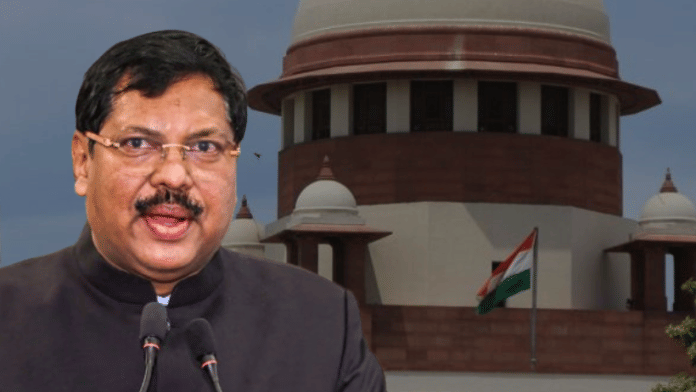Thank you dear subscribers, we are overwhelmed with your response.
Your Turn is a unique section from ThePrint featuring points of view from its subscribers. If you are a subscriber, have a point of view, please send it to us. If not, do subscribe here: https://theprint.in/subscribe/
On October 6, 2025, a lawyer in India’s Supreme Court drew his shoe and hurled it at Chief Justice B. R. Gavai, screaming: “Sanatan ka apmaan nahi sahenge” (“We will not tolerate the insult of Sanatan Dharma”). This was not just an act of disrespect toward an individual — it was a symbolic response to what many believe was itself a blow struck by the Chief Justice against the religious sentiments of the Hindu majority. The insult was not spontaneous or accidental; it is now part of a fraught narrative about jurisprudence, identity, history—and the fragile duty of judges to balance free reasoning with respect.
What makes this drama more combustible is the person at its center: CJI Gavai, who comes from a prominent Ambedkarite Buddhist-heritage family. His father, R. S. Gavai, embraced Buddhism during Ambedkar’s 1956 conversion movement, and is associated with having helped erect in Nagpur a marble plaque (or pillar) inscribed with the 22 Vows — the vows by which converts renounced Hindu deities, Hindu dogma, social ritual, and pledged allegiance to Buddhism and moral equality. That pillar still stands in Deekshabhoomi, a towering symbol of a religious and social rupture. The Gavai lineage does not merely occupy a judicial pedestal; it is enmeshed in a contested history of religious dissent.
So what do we make of a Chief Justice, born into a legacy of rejecting Sanatana Dharma, presiding over a PIL concerning a Lord Vishnu idol, and reportedly quipping, “ask your deity to act”? A judge is not a mere mortal in robes; his words carry weight, echo in legal texts, set tone for forums, and shape public trust. In such a fraught context, the temptation to mock the religious premise of a petition—especially one that appeals to devout belief—moves perilously close to the point where justice appears partial, dismissive, even arrogant.
Let us dispense with euphemisms: the remark attributed to Gavai is disrespectful. Whether he intended to belittle or merely provoke interlocutors, the effect cannot be ignored. In India, religious identity is not an abstract footnote; it is a live sinew of society and sentiment. For a judicial officer—even one as intellectually formidable as Gavai—to make a quip that appears to mock faith, doctrine, or ritual is no small matter. It is a provocation, and a grave one. It turns a court into a theater of culture war, not adjudication.
Let us also be clear: a single quip does not always amount to bias or disqualification. Indian jurisprudence is replete with doctrines which demand that recusal or reversal rest on reasonable apprehension of bias and a “real likelihood” standard. Written judgments, not stray oral remarks, carry binding force. Judges should speak through reasoned, respectful orders. But that standard is not a license for careless or flippant stereotyping of religious belief. The doctrine of nemo judex in causa sua demands not just neutrality, but the appearance of fairness. In matters where religious sentiment sits at the heart, judges must tread with scrupulous care.
Timorousness is not the answer either. The judiciary must not shrink from confronting bogus idol vandalism, restoration claims, or symbolic religious disputes. But it must do so with dignified language. Dismissing a devotional claim with derision or sarcasm pushes the adjudicative process toward alienation, reducing public faith in the “temple of justice.” The court’s robe should not shield caustic commentary.
The attempted shoe-throwing was itself a violation of the decorum of justice. Courts cannot function under threat, and no one in the judiciary should be subjected to assault. But that act came only because many perceived the court had already struck first—with words. The insult was not in the shoe; it was in the language. The shoe was the response.
In a democracy of many faiths, judges are not translators of theology—they are interpreters of law. But they cannot pretend that believers, rituals, and sacred narratives are irrelevant. When one side believes Vishnu is not just myth but living divinity, a quip like “ask your deity” is not irreverent banter—it is dismissal of the very premise of faith. A court that treats its dispensations as mere puzzles may win in logic but lose in legitimacy.
Chief Justice Gavai does not need to abandon his Buddhist heritage. But as the face of India’s judiciary, he must recognize that his voice now carries a responsibility far beyond legal correctness: it bears the weight of public conscience. If justice is to persuade, it must not merely rule — it must resonate. Words matter. Tone matters. In the winding chambers of Indian faith, a judge’s misstep can scar trust permanently. That is a cost no court should bear.
Mohan Murti
Advocate
Former Managing Directer-Europe
Reliance Industries Ltd. Germany
These pieces are being published as they have been received – they have not been edited/fact-checked by ThePrint.


